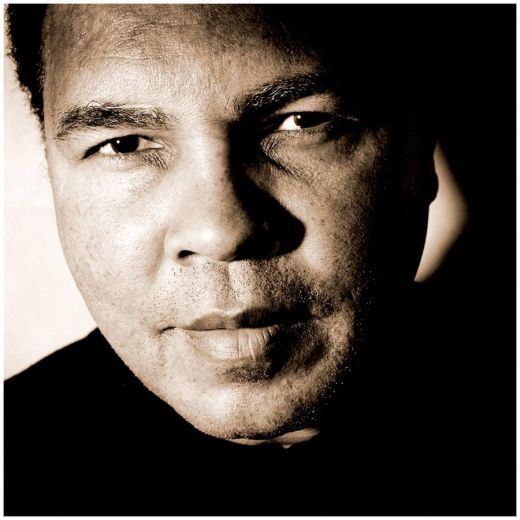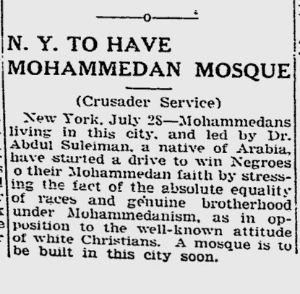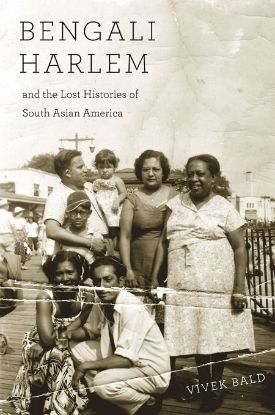Sometimes a picture is worth a thousand words. One of the most well-known, recognized and beloved Americans of all times—world-wide—is Muhammad Ali.
Ali may be the face many of us connect to when thinking of black Americans and Islam, but the roots of Islam in America go back to the founding, and have been a key part of black American culture.
I had written something else for today, and decided to scrap it. I’m beyond angry.
The dangerous witch-hunt spews from Trump and his rabid supporters, the anti-Muslim hysteria in the press and online strikes close to home for me. I am not Muslim, though I often wear a head-wrap. My husband’s name is Nadhiyr, and he is the Puerto Rican grandson of a South Asian immigrant. I have cousins who are Muslim and I spent my teenage years in a neighborhood in Queens NY where many of my neighbors were black American jazz musicians — who were Muslim.
The History
The PBS History Detectives Series, did a feature on “Islam in America” which covered a lot of the roots.
When the first Muslims came to the land that would become the United States is unclear. Many historians claim that the earliest Muslims came from the Senegambian region of Africa in the early 14th century. It is believed they were Moors, expelled from Spain, who made their way to the Caribbean and possibly to the Gulf of Mexico. When Columbus made his journey to the United States, it is said he took with him a book written by Portuguese Muslims who had navigated their way to the New World in the 12th century.
Others claim there were Muslims, most notably a man named Istafan, who accompanied the Spanish as a guide to the New World in the early 16th century in their conquest of what would become Arizona and New Mexico. What is clear is the make up of the first real wave of Muslims in the United States: African slaves of whom 10 to 15 percent were said to be Muslims. Maintaining their religion was difficult and many were forcibly converted to Christianity. Any effort to practice Islam, and keep the traditional clothing and names alive had to be done in secret. There was an enclave of African-Americans on the Georgia coast that managed to maintain their faith until the early part of the 20th century.
They cite some demographic data:
The estimated number of Muslims in this country varies, depending on the source. The American Muslim Council claims 5 million, while the non-partisan Center for Immigration Studies believes the figure is closer to between 3 to 4 million followers of Islam. The American Religious Identification Study by the City University of New York, completed in 2001 put the number of Muslims at 1, 104,000. Over the years, the nation gained public prominence due to famous members like Malcolm X and Muhammad Ali. Today, there are more than 1500 Islamic centers and mosques around the country.
Figures vary, but experts estimate that between four and seven million Americans are Muslim.Islam is expected to soon be the second largest religion in America. Since the attacks of 9/11, prejudice against Muslims has risen sharply.
I attended Mosque #7 in New York to hear Malcolm X speak. The Islamic Cultural Center, in East Harlem, which started construction in 1987 claims to be NYC’s first mosque, but that isn’t the truth. Temple #7 opened in 1946 at the Harlem YMCA.
Martin Nguyen, Assistant Professor of Islamic Religious Traditions at Fairfield University, has some very interesting data on his blog Islamicana. Kiran Tahir’s post “New York’s First Mosque?” includes this news clipping from 1923.
N.Y. To Have Mohammedan Mosque
(Crusader Service)
New York. July 28 – Mohammedans living in this city, led by Dr. Abdul Suleiman, native of Arabia, have started a drive to win Negroes [t]o their Mohammedan faith by stressing the fact of the absolute equality of races and genuine brotherhood under Mohammedanism, as in opposition to the well-known attitude of white Christians. A mosque is to be built in this city soon.
There is also the fascinating, and mostly overlooked history of Muslim immigrants from South Asia. Bengali Harlem and the Lost Histories of South Asian America, by Vivek Bald, tells their stories.
In the final years of the nineteenth century, small groups of Muslim peddlers arrived at Ellis Island every summer, bags heavy with embroidered silks from their home villages in Bengal. The American demand for “Oriental goods” took these migrants on a curious path, from New Jersey’s beach boardwalks into the heart of the segregated South. Two decades later, hundreds of Indian Muslim seamen began jumping ship in New York and Baltimore, escaping the engine rooms of British steamers to find less brutal work onshore. As factory owners sought their labor and anti-Asian immigration laws closed in around them, these men built clandestine networks that stretched from the northeastern waterfront across the industrial Midwest.
The stories of these early working-class migrants vividly contrast with our typical understanding of immigration. Vivek Bald’s meticulous reconstruction reveals a lost history of South Asian sojourning and life-making in the United States. At a time when Asian immigrants were vilified and criminalized, Bengali Muslims quietly became part of some of America’s most iconic neighborhoods of color, from Tremé in New Orleans to Detroit’s Black Bottom, from West Baltimore to Harlem. Many started families with Creole, Puerto Rican, and African American women.
Young Puerto Ricans who founded Alianza Islamica in East Harlem, in 1975, included Latin Jazz artist and WBAI radio host Ibrahim Gonzales, known as “Mambo Dervish” to his listeners. Ibrahim passed away two years ago.
He was a friend, and thinking about him today, made me reflect on the music I grew up with and still love. We don’t often think of jazz, as influenced by Islam, and yet so many jazz artists of note, embraced the faith.
The list is a long one — including drumming great Art Blakey, and many of his jazz Messengers, “Sahib Shihab (alto saxophone), Orlando Wright (Musa Kaleem, tenor saxophone), Kenny Dorham (Abdul Hamid, trumpet), Howard Bowe (Haleen Rasheed, trombone), Walter Bishop (Ibrahim Ibn Ismail, piano)”
Musicians like McCoy Tyner, Jackie McLean, Ahmad Jamal, Grant Green, Yusef Lateef, and Pharoah Sanders were/are Muslim. That list includes the jazz vocalist Aliyah Rabia who used the stage name Dakota Staton, I knew her as my friend Farouk’s mom — Mrs. Dawud. As a teenager I spent time running in and out of the home of John Coltrane, whose wife Naima was Muslim, and though it is not clear if Trane ever converted, his music was clearly influenced by Islam — there is an interesting piece discussing this, at AlJazeera: Did Coltrane say ‘Allah Supreme’?
For those of you who are not jazz fans, you probably know the music of Kool and the Gang — who were also Muslim, and there are many young rappers who are Muslim as well.
I’ll stick to jazz today.
Here’s Ahmad Jamal in Paris.
I’m listening to the Pharoah Sanders classic, “ The Creator has a Master Plan” as I type this.
There was a time, when peace was on the earth
And joy and happiness did reign and each man knew his worth
In my heart how I yearn for that spirit’s return
And I cry, as time flies
Om, Om
There is a place where love forever shines
And rainbows are the shadows of a presence so divine
And the glow of that love lights the heavens above
And it’s free, can’t you see, come with me
The creator has a master plan
Peace and happiness for every man
The creator has a working plan
Peace and happiness for every man
The creator makes but one demand
Happiness through all the land
Peace.




The attacks on our Muslim brothers and sisters are attacks on all of us.
I was glad to see ministers and rabbis denouncing Donald Trump today.
Thank you Dee…..
Thanks pp – we have to keep that thought alive.
Thank you for this history! As always, I learn something from your posts. I was struck by this snippet from the news clipping of 1923:
The well-known attitude of white Christians, indeed. I have always wondered at the embrace of Christianity by black Americans since it was the religion of their masters and was often used for oppression even after their legal slavery ended. I can see why Islam may be been attractive.
I am not of either religion and organized religions in general, and their fundamentalist adherents in particular, make me very itchy. But we need to protect freedom of religious expression and push back fiercely against religious bigotry.
The good news is that that Republican Party is not only wrong but their candidates are pursuing policies that are blatantly unconstitutional. Let’s hope that this starts a national conversion that includes the embarrassing Korematsu SCOTUS decision … and cries of “Never Again” from people of good will.
A different sort of Justice Roberts than the one we have, Justice Owen Roberts, wrote the key dissent:
“… without evidence or inquiry concerning his loyalty and good disposition towards the United States”.
Unconstitutional then, unconstitutional now.
p.s. Thanks for the music!
Many of the people I knew who became Muslim – did so in reaction to racist Christians.
I had problems with what I viewed as standard male chauvinism in all of it – and opted for an afro-pagan-ish choice. Not that santeria doesn’t have male chauvinists – but I have the option to simply worship in my own home with my mostly gay god-kids.
Tom Brokaw, last night, via Media Matters for America:
Thank you for posting that Jan
From @anildash:

I’ve been waiting for that – thanks!!!